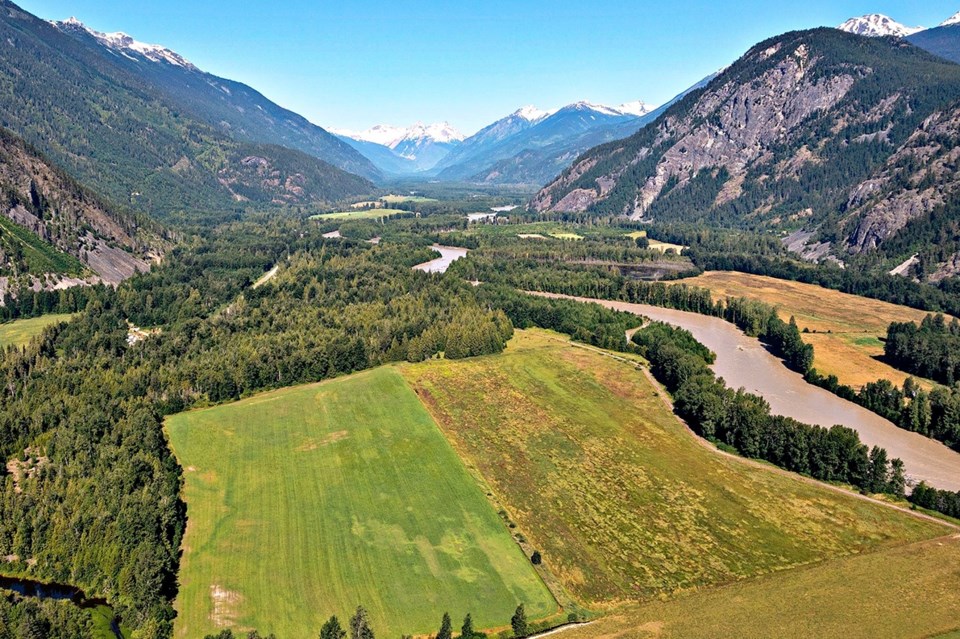After launching a fundraising bid earlier this year, the BC Parks Foundation has carried out the $2.6 million purchase of 46.5 hectares of Agricultural Land Reserve (ALR) land in the Pemberton Meadows.
The independent charity arm of BC Parks describes the lot in question as a “critical corridor” for endangered grizzly bears, while some local officials and farmers are raising red flags over food security, land use and public safety.
Jennie McCaffrey, acting CEO of the Foundation, confirmed the land, known as District Lot 813, was acquired in July after being identified by the Coast to Cascades (C2C) Grizzly Bear Initiative as “really important” to the long-term survival of two at-risk bear populations: the Stein-Nahatlatch and South Chilcotin.
“It really sits at the intersection of two threatened grizzly bear populations,” McCaffrey told Pique. “While this property isn’t a core feeding or breeding area, it plays a role in keeping that door open for movement and genetic exchange between populations.”
The Stein‑Nahatlatch grizzly bear population in B.C. numbers only about 20 bears, with an estimated half-dozen breeding females, according to C2C. The species is critically endangered and genetically isolated, facing threats from habitat fragmentation, poaching, and motorized access.
By contrast, the larger South Chilcotin Ranges population hosts roughly 200 to 220 bears. Though more robust, it is still listed as threatened due to habitat loss, human development and limited connectivity.
The parcel purchased by the Parks Foundation is bordered on two sides by Crown land and lies within a broader conservation strategy to protect wildlife movement corridors in B.C.’s South Coast. The Foundation says the land had not been actively farmed in more than two years and stresses conservation is a permitted use within Agricultural Land Reserve (ALR) zoning. The provincial ALR system exists to protect valuable farmland from development.
But several voices in the community—including Squamish-Lillooet Regional District (SLRD) Electoral Area C director Russell Mack—have expressed concern about the implications.
“They’re gonna plant all sorts of berries and attractants in there,” Mack said during the July 24 SLRD board meeting.
“[Residents have] been told flat out by conservation—everyone in the valley—that you have to put electric fences up, you shouldn’t have fruit trees, you shouldn’t even have animals on your farm because they attract the bears… and now these people are actually planting attractants.”
McCaffrey clarified this point directly: “We are not planting any berries. There is no plan to plant berries on that property. That was a mistake that appeared in a Q&A and has since been corrected.”
Mack also criticized the Foundation’s broader strategy of acquiring agricultural land, arguing the land could be better used to support food production.
“They’re buying these up and taking them out of production. So, here we’ll use these 100 acres of farmland—prime farmland on the valley floor," he said. "The bears don’t need to be attracted to civilization. They should be up in the high country where they belong.”
These sentiments are echoed in letters submitted to the SLRD from longtime farming families. A letter from Chad Gilmore, of the multi-generation Gilmore Bros. Farms operation, warned the acquisition could worsen food insecurity.
“Given the reduction of land for farming and the ongoing question of food security in the province, removing 46.5 hectares of land permanently from our small and already impacted Valley is incomprehensible,” the letter read.
Another letter from farm owner Susan Hellevang pointed out while farmers are penalized for attracting bears under the Wildlife Act, the Foundation appeared to be allowed to do just that.
“We are told that grizzly bear habituation is dangerous—for the animals and the people—and are expected to invest heavily in electric fencing and deterrence methods,” she wrote. “Yet now we are being told that this parcel of land will be planted with vegetation and berry bushes specifically to attract bears.”
McCaffrey pushed back on suggestions grizzlies will be drawn into developed areas, stating that secure, undeveloped corridors can reduce human-wildlife conflict.
“Protecting habitat actually helps keep bears and people safe by providing secure spaces for bears to move, feed and rest without entering developed areas,” she said. “Grizzlies tend to avoid people. They can travel within 100 metres of homes and farms without ever being seen.”
According to SLRD director of planning and development Kim Needham, while the land is zoned as ALR, there is no legal requirement to farm it.
“There is no obligation to actually farm within the [ALR],” she said during the board meeting. “There are tax incentives… but there is no incentive to actually utilize farm land for farming.”
Area B director Vivian Birch-Jones expressed skepticism over the connection to local grizzly conservation efforts.
“I’m all in favour of grizzly bears and the Stein-Nahatlatch population is dear to my heart, but I do not connect these dots at all," she said. "And I don’t see how this benefits that population.”
McCaffrey maintains the acquisition aligns with broader biodiversity goals.
“This area has incredible ecosystem value,” she said. “This is a very biodiverse area with a waterfront, which is critical to allow lots of different wildlife access to the water, so it has a whole host of values for the entire area. So we're not just talking about grizzlies in this case, but that's definitely been the focus of the campaign.”
When asked about the loss of agricultural potential, McCaffrey suggested the Foundation remains open to exploring sustainable farming down the line.
“There’s a potential to explore sustainable farming practices in the area that can coexist with wildlife,” she said. “That’s not off the table.”
As for next steps, the Foundation plans to begin engagement with local governments, conservation groups, First Nations and other stakeholders over the next year. A formal consultation process is anticipated in 2026 as work gets underway.
The SLRD, for its part, has passed a motion directing staff to provide a report on policy options related to purchases of ALR land for conservation, as well as background information on the BC Parks Foundation itself.
Despite the outcry, McCaffrey says the Foundation has heard support from many corners, including Sea to Sky residents, donors from across Canada and local MLAs.
“The protection of 46.5 hectares of riverfront habitat is something for all of us to celebrate in B.C.,” she said. “It’s the kind of lasting impact that doesn’t happen without the people of B.C. stepping up.”
Information on the Foundation’s successful fundraising bid can be found on its website.




